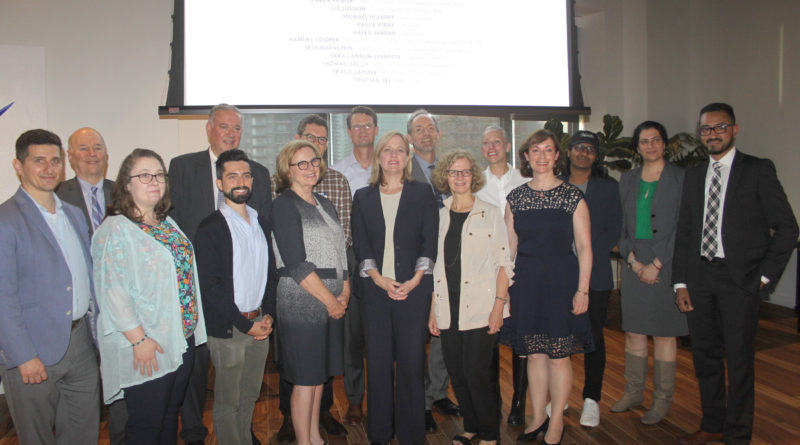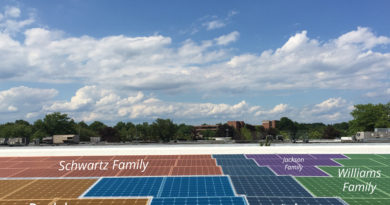Katz unveils western Queens tech plan
BY BENJAMIN FANG
With a new roadmap for equitable growth, western Queens is well on its way to becoming the technology center of the borough.
Borough President Melinda Katz joined educational, business and community leaders at WeWork Queens Plaza to unveil the Western Queens Tech Plan, a strategic list of initiatives to strengthen the infrastructure and possibilities of the tech ecosystem.
The tech plan, created by the borough president’s task force that was initiated in 2011, centers on Long Island City, a neighborhood that is experiencing a boom in residents, businesses and employees.
The neighborhood already has anchor institutions like JetBlue, CUNY Law School and LaGuardia Community College, as well as a connected transportation network and a local talent pool. Katz said that makes it “an ideal source for talent ripe for tech businesses.”
Long Island City is part of New York City’s bid to court Amazon’s second headquarters, and is expected to benefit from the new Cornell Tech campus on Roosevelt Island.
“We have the best inherent assets to foster innovation,” Katz said.
Despite being in good position for tech job growth, Queens has lagged behind the city’s rate of job creation in the field. The borough president said there was only a 10 percent growth in the last decade, but in the same period, New York City experienced a 28 percent growth in tech jobs.
“We need to do better, and we can do better,” she said.
Kate Wittels, a partner at the firm HR&A Advisors, which helped create the plan, added that Long Island City has always had a tech base, but it needs to continue to expand.
“We just need to be a little organized and thoughtful of how we’re exploring our programs and leveraging our assets,” she said.
The strategic plan is focused on six initiatives broken down into three categories. The first focal point, called “People-Focused Initiatives,” aims to connect local residents to tech training programs, and eventually build a pipeline to job opportunities.
The plan calls for securing more federal and state funding to expand pre-training programs, with a focus on supporting underrepresented communities, and building stronger partnerships between the city and tech employers.
At the heart of this initiative is LaGuardia Community College. Gail Mellow, president of the college, said LaGuardia already has 3,500 students annually studying technology. The more difficult part will be to connect those students with future employers.
“We also have to change the mindsets of the employers, who don’t look at our students and say ‘tech geek,’” Mellow said. “But they are.”
The next two initiatives are “place-based,” seeking to foster the creation of more tech-supportive spaces. The plan calls for finding 300 acres of “strategic nodes” to focus investment, and creating more density of activity to link the tech ecosystem together.
The plan also proposes developing a 40,000 to 60,000-square-foot physical hub for tech and innovation, equipped with tools and training for emerging companies.
Elizabeth Lusskin, president of the Long Island City Partnership, said the report identifies three clusters where this could happen: educational spaces, visual and performing arts spaces and the waterfront.
“Once you have the space, you can go toward a variety of activities that provide that fertile interaction and exposure,” Lusskin said. “And provide people with exposure to the career paths of things you can do.”
The last two initiatives are programmatic. The plan calls for more marketing of the western Queens tech opportunities by creating a recognizable brand. It also proposes creating new economic development tools to incentivize private sector investments and job creation.
To implement the strategies laid out in the plan, Katz announced the creation of a Western Queens Tech Council, made up of many of the same leaders who created the plan. Implementation will begin this summer.
“We need a tech council to make sure all of the initiatives are fulfilled,” she said.
Thomas Grech, president and CEO of the Queens Chamber of Commerce and a member of the new tech council, said the vision plan will define the next half-century in Queens.
“There’s a great opportunity to make something really special that is transformative,” he said.
He noted that the borough has seven colleges and universities with more than 70,000 students. They will be central to executing the plan in the future as well.
“We want them to go to school, grow and prosper, and then not go to Silicon Valley or Route 128 in Boston, but to apply their craft here in Queens,” Grech said.




